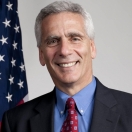
So I’m on my way to do a TV interview last night on a set of middle-class initiatives we announced yesterday, when I learn that what they really want to talk about is our proposed freeze on non-security discretionary spending. Ok — I’m flexible — and in fact, the two are related in an important way that folks need to understand.
First, an important note on timing. No one is arguing that we should take our foot off the accelerator today, when the economic recovery remains fragile and job growth has yet to return. In fact, you’ll hear from the President tomorrow night about measures we should undertake right away jumpstart job creation. In his words and deeds, the President has made clear that recovery comes first. But that doesn’t mean we should wait to start changing the same bad habits in Washington that left a $1.3 trillion deficit on our doorstep when we entered office in January 2009, especially when we can do so without cutting back on our jobs agenda.
Second, a little background on freeze-eology: there are two ways to do a freeze like this: (1) an across-the-board freeze on every program outside of national security; and (2) a surgical approach where overall totals are frozen but some individual programs go up and others go down. In short, a hatchet versus a scalpel.
During the campaign, you may recall that John McCain touted option 1 – the hatchet approach of an across-the-board freeze.
The President was critical of that approach then, and we would be critical of it now. It’s not what we’re proposing. To the contrary, the entire theory of the President’s proposed freeze is to dial up the stuff that will support job growth and innovation while dialing down the stuff that doesn’t. Under our plan, some discretionary spending will go up; some will go down. That’s a big difference from a hatchet.
Take, for example, the policies we announced yesterday — a significant expansion (a 20% increase) in a program that provides services for seniors, like respite care and in-home services; a program to limit student loan repayments to 10 percent of income (after living expenses); an expansion of two tax credits, one for child care and another for retirement savings.
How can we expand these programs in the context of a freeze? By making sure that the freeze either holds steady or increases those parts of the discretionary budget that support jobs and income security for folks who need them, while whacking the wasteful subsidies that support lobbyists and special interests.
President Obama deeply understands the various imperatives of this moment in time, even if they don’t always point in the same direction.
We must do all we can to help those who are still reeling from the impact of the great recession; we must create the economic conditions for robust, private-sector job growth, and we must make the investments in clean energy, health care, and education that will ensure that the next economic expansion is characterized by broadly shared prosperity, not narrow gains to financial speculators.
At the same time, we must take steps to move toward a sustainable fiscal position, and that’s where the discretionary freeze comes in.
You can’t thread that needle with a hatchet. You’ve got to use a scalpel. That may be a truly lousy metaphor, but it’s good public policy.
Jared Bernstein is Chief Economist to Vice President Biden, and Executive Director of the Middle Class Task Force


